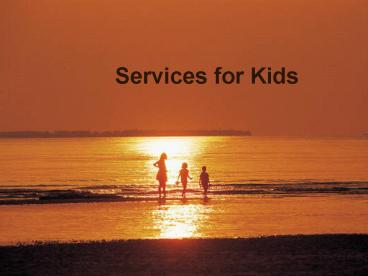Services for Kids - PowerPoint PPT Presentation
1 / 34
Title:
Services for Kids
Description:
Mindfulness, MBCT, MI-CBT. Art, music, equestrian therapy. Neurofeedback ... Mindfulness. Yoga, etc. Exercise. Massage. Side to side. Peak experiences. Appreciation ... – PowerPoint PPT presentation
Number of Views:96
Avg rating:3.0/5.0
Title: Services for Kids
1
Services for Kids
2
Interestingly enough, a large portion of that
25 percent were kids who were initially referred
for runaway.They scored the highest in
terms of self-esteem, self-preservation, and
ability to differentiate responsibility.
When we did sample psychological testing of that
whole group, heres what we found Overall, the
children in the problem category tested out
much healthier mentally.They showed
higher self-esteem, stronger self-preservation
instincts, and a clearer sense of who was
responsible for what.
Cathleen Brooks
3
Things may be fine
4
- Youre not alone
- Its not your fault
- These are illnesses
- People with problems can and do recover
- Youre worthy
- you deserve help
5
- Accessible to all children
- Context of kids realities
- Create safety
- Respect defenses
6
- Creativity (with safety)
- Healing environment
- Respect and concern
7
Resilience?
8
The Safe (Strong) Container
9
Working With Families
10
Parents Trauma Histories
- Attachment
- Regulation
- Judgment
- Anxiety
- Self-absorption
- Protection
- Responsibility
11
A Few Skills
- Hope
- Willingness
- Empowerment
- Support network
- Self-awareness
- Insight
- Attachment
- Proactivity
- Planning
- Affiliation
- Direction
- Purpose
12
Family Recovery(White Savage, 2005)
- Health and functioning
- Subsystem relationships
- Roles, rules, rituals
- External relationships
- ? kids risk
13
- Physical, psychological, social, spiritual
- Family living skills
- Parent and recovery strategies
- Life skills (e.g., conflict, communication,
problems, nutrition) - Tailored to learning challenges
14
Flood Control
15
Trauma Support and Treatment
16
Vision Trauma-Informed Care
17
Single-Session TherapyNot a Good Idea.
18
Safety First
- Normalize
- Negotiate
- Self-regulation
- Pacing
- Talk to the amygdala
- Monitor medications
- Safe environment?
- Take care of yourself
19
Building Trust
- Radar
- Defenses
- Boundaries
- Pass the test
- Mistakes
- Connection
- Authenticity
- Navigate emotions
Build Trust
20
- Involve consumers
- Be a teacher
- Answer the big question
- Triage challenges
- Collaborate
- Build skills
- Talk to strengths
- Point to resources
- Embody Hope
- Foster the vision
Focus on Empowerment
21
Art for Kids (Safely)
22
What makes them effective?
- Mainstream, e.g.
- CBT, TF-CBT
- EMDR
- Systematic Desensitization, Exposure
- DBT
- TREM
- Seeking Safety
- Approaching Mainstream, e.g.
- Mindfulness, MBCT, MI-CBT
- Art, music, equestrian therapy
- Neurofeedback
- Somatic and Somatosensory, e.g.
- Somatic Experiencing
- Trauma Resiliency Model/Veterans Resiliency Model
- Somatic Trauma Therapy
- Trauma Releasing Exercises
- Tapping (e.g., TFT, EFT)
- Craniosacral Therapy
All Kinds of Approaches
23
No Great Mystery
- Motivation
- Targeting symptoms
- Reconnecting with the body
- Visualization
- Making it concrete
- Replacing thoughts
- Managing emotions
- Breaking down problems
- Being here now
- Inner observer
- Integration
24
A Few Recovery Tools
- Attunement
- Breathing
- Observing
- Presence
- Labeling emotions
- Mindfulness
- Yoga, etc.
- Exercise
- Massage
- Side to side
- Peak experiences
- Appreciation
25
Ritual and Healing
- Ritual and the brain
- In recovery activities
- Finding safe rituals
- Self-designed rituals
- Faith rituals
- Family rituals
- Community rituals
26
Meaning, Purpose, Transformation
- Posttraumatic growth
- Grieving
- Forgiveness
- Atonement
- Acceptance
- New meaning
- Strength at the broken places
- Transcendence
- Transformation
27
Determining Percentages of Responsibility
(Scurfield, 2006)
28
Trauma-Informed Systems
29
The Nexus Prevention, Treatment, Recovery
30
A culture rooted in
Safety
Choice
Trustworthiness
Collaboration
Empowerment
(Roger Fallot, PhD Sidran Institute)
31
All aspects
All groups
A new routine
Thinking
Understanding
32
A Few Placesto Start
- www.trauma-pages.org
- http//mentalhealth.samhsa.gov/nctic/
- www.ptsd.va.gov
- pamelawoll_at_sbcglobal.net
33
Resilience Grows Back
Pam Woll(773) 334-7531pamelawoll_at_sbcglobal.net
34
(No Transcript)































